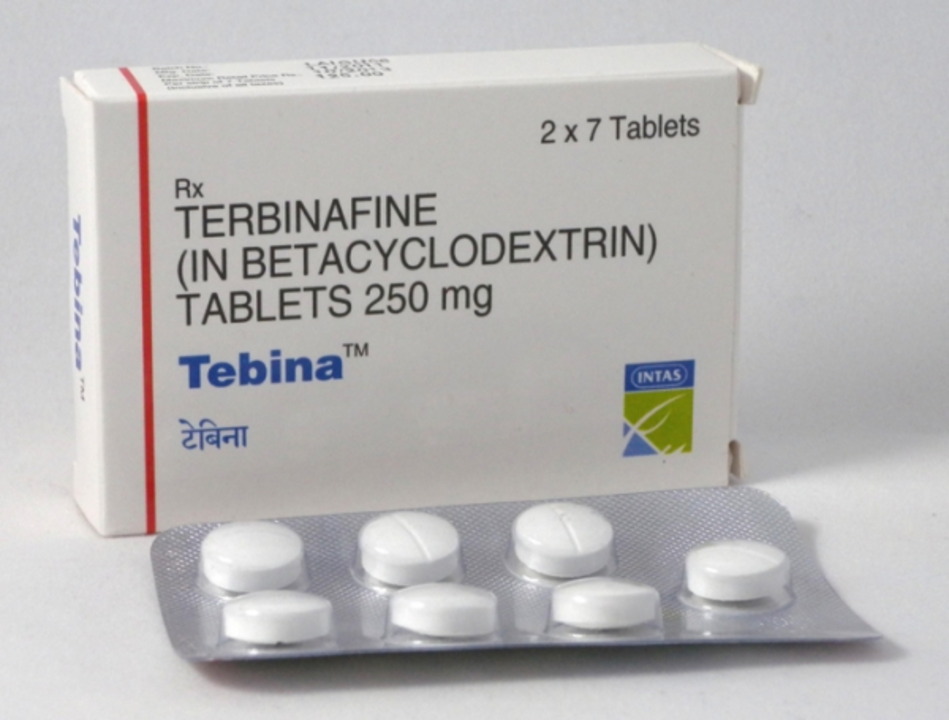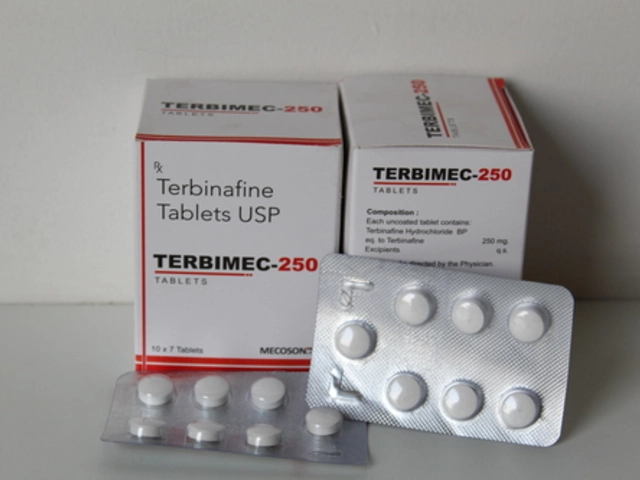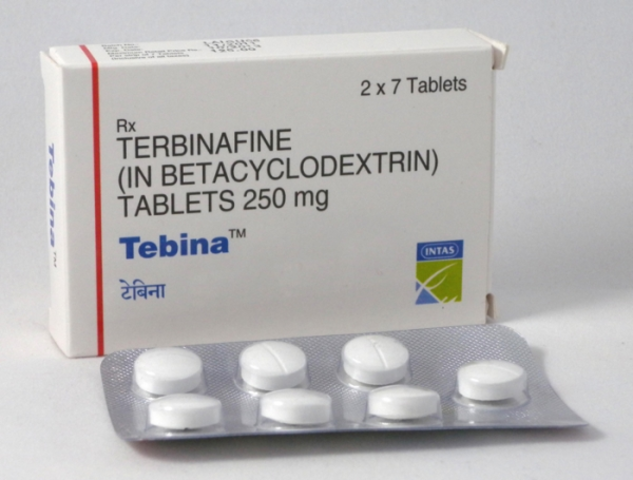6
The ultimate guide to understanding terbinafine and its uses

An Introduction to Terbinafine
Welcome to the ultimate guide to understanding terbinafine and its uses! In this article, we will explore the ins and outs of terbinafine, a powerful antifungal medication. We will discuss what terbinafine is, how it works, and the various conditions it can treat. By the end of this guide, you will have a comprehensive understanding of this medication and how it can benefit you or your loved ones.
What is Terbinafine?
Terbinafine is an antifungal medication that is commonly used to treat fungal infections on the skin, nails, and hair. It belongs to a class of drugs called allylamines, which work by interfering with the production of a substance called ergosterol. This substance is essential for the growth and survival of fungi, so by disrupting its production, terbinafine effectively kills the fungal cells and prevents the infection from spreading.
How Does Terbinafine Work?
Now that we know what terbinafine is, let's delve deeper into how it works. As mentioned earlier, terbinafine belongs to the allylamines class of antifungal medications. These drugs work by inhibiting an enzyme called squalene epoxidase, which is crucial for the synthesis of ergosterol. Ergosterol is a vital component of fungal cell membranes, so without it, the fungal cells become weak and susceptible to damage. Eventually, the fungal cells die off, and the infection is cleared.
Conditions Treated by Terbinafine
Terbinafine is a versatile medication that can treat various fungal infections. Some of the most common conditions treated by terbinafine include:
- Athlete's foot (tinea pedis): Terbinafine is highly effective at treating this common fungal infection that affects the skin between the toes and the soles of the feet.
- Jock itch (tinea cruris): This fungal infection affects the groin area and can be successfully treated with terbinafine.
- Ringworm (tinea corporis): Terbinafine is an excellent choice for treating ringworm, a fungal infection that causes a red, circular rash with a clear center.
- Fungal nail infections (onychomycosis): Terbinafine can also be used to treat fungal infections of the nails, although it may require a longer course of treatment.
Terbinafine Formulations and Dosage
Terbinafine is available in various formulations, making it easy to find the right treatment for your specific fungal infection. The most common forms of terbinafine include:
- Topical cream or gel: This is applied directly to the affected area and is ideal for treating skin infections such as athlete's foot, jock itch, and ringworm.
- Spray: A spray form can be used for hard-to-reach areas or for those who prefer a less messy application.
- Oral tablets: Oral terbinafine is typically used for more severe infections, such as fungal nail infections, or when topical treatments have not been effective.
The dosage of terbinafine will depend on the severity and location of your infection. It's essential to follow your healthcare provider's instructions and complete the entire course of treatment to ensure the infection is fully cleared.
Side Effects of Terbinafine
Like all medications, terbinafine can cause side effects. However, most people who use terbinafine will not experience any significant issues. Some common side effects of terbinafine include:
- Redness, itching, or stinging at the application site (for topical formulations)
- Headache
- Stomach upset
- Diarrhea
If you experience any severe side effects or an allergic reaction to terbinafine, contact your healthcare provider immediately. It's essential to discuss any concerns you may have about side effects with your healthcare provider before starting terbinafine.
Precautions and Interactions
Before starting terbinafine, it's crucial to inform your healthcare provider of any other medications you are taking, as terbinafine can interact with certain drugs. Additionally, let your healthcare provider know if you have any history of liver or kidney problems, as terbinafine can potentially cause liver damage in rare cases.
While using terbinafine, it's essential to keep the affected area clean and dry, as moisture can encourage fungal growth. Avoid sharing personal items such as towels, clothing, and shoes with others, as fungal infections can be contagious.
Conclusion
Terbinafine is a highly effective antifungal medication that can treat a wide range of fungal infections. By understanding how terbinafine works and how to use it safely, you can ensure a successful treatment outcome. If you suspect you have a fungal infection, consult your healthcare provider to discuss whether terbinafine is the right treatment option for you.










Nick Ward
May 6, 2023 AT 03:34Thanks for the thorough guide, this really helps demystify terbinafine 😊.
felix rochas
May 8, 2023 AT 11:07Are you sure the pharma giants aren't hiding side‑effects? The marketing spin is everywhere!!! They push terbinafine like a miracle cure without mentioning the rare liver toxicity, the drug interactions, or the long‑term resistance issues-watch out!!!
inder kahlon
May 10, 2023 AT 18:41Terbinafine works by inhibiting squalene epoxidase, which stops ergosterol synthesis and weakens fungal cell membranes. Topical forms handle skin infections, while oral tablets are needed for onychomycosis. Completing the full course prevents relapse.
Dheeraj Mehta
May 13, 2023 AT 02:14Exactly! It’s great to see a quick rundown-keeps the vibe positive and the info digestible 😊.
Oliver Behr
May 15, 2023 AT 09:47In the UK we often see terbinafine gel sold over‑the‑counter for athlete’s foot, but we still advise a pharmacist check for liver issues before starting long courses.
Tiffany W
May 17, 2023 AT 17:21From an ethical standpoint, prescribing terbinafine without thorough patient education breaches informed‑consent protocols, especially given its hepatotoxic potential and the need for hepatic monitoring.
Rajeshwar N.
May 20, 2023 AT 00:54Honestly, the guide glosses over the fact that many people just pop a tablet and expect instant nail recovery-unrealistic and potentially dangerous. The drug’s bioavailability and tissue penetration vary, so results aren't guaranteed.
Louis Antonio
May 22, 2023 AT 08:27Look, if you think a cream will magically cure a thick fungal nail, you’re dreaming. Topicals rarely reach the nail matrix; oral therapy is the only real option for that.
Kyle Salisbury
May 24, 2023 AT 16:01Different cultures have varying grooming habits that affect fungal spread; for example, communal bathing in some regions raises infection risk, making topical prevention essential.
Angie Robinson
May 26, 2023 AT 23:34The article fails to mention the cost disparity for oral terbinafine across insurance plans, which can lead patients to abandon therapy prematurely.
Emmons Kimery
May 29, 2023 AT 07:07Remember to keep the affected area dry and avoid sharing towels-simple steps that boost treatment success 👍.
Mimi Saki
May 31, 2023 AT 14:41Sending supportive vibes to anyone battling a stubborn fungal infection! You’ve got this 💪😊.
Subramaniam Sankaranarayanan
June 2, 2023 AT 22:14Terbinafine, a member of the allylamine class, exerts its antifungal activity primarily through irreversible inhibition of the enzyme squalene epoxidase, a pivotal step in the ergosterol biosynthetic pathway.
By blocking this enzyme, intracellular squalene accumulates to toxic levels, compromising fungal cell membrane integrity and ultimately leading to cell death.
Pharmacokinetically, the oral formulation boasts a high bioavailability of approximately 70% and distributes preferentially into keratinous tissues, which explains its efficacy in onychomycosis.
However, the hepatic first‑pass effect necessitates careful monitoring, especially in patients with pre‑existing liver disease or those consuming concomitant hepatotoxic agents.
Clinically, treatment durations vary dramatically: topical preparations may be applied twice daily for two to four weeks, whereas oral therapy often extends to twelve weeks for nail infections.
Adherence is a critical determinant of success; incomplete courses frequently result in relapse and may foster resistant fungal strains.
Resistance mechanisms, though infrequent, have been documented and involve mutations in the SQLE gene that diminish drug binding affinity.
From a safety perspective, common adverse effects include mild localized irritation for topicals and, less commonly, gastrointestinal upset, headache, and a transient elevation of hepatic transaminases for the systemic form.
Rare but serious reactions such as Stevens‑Johnson syndrome or drug‑induced hepatitis mandate immediate discontinuation and urgent medical evaluation.
Drug–drug interactions are particularly noteworthy with agents that are strong inhibitors or inducers of the cytochrome P450 isoenzyme CYP2D6, which can alter terbinafine plasma concentrations.
Therefore, a comprehensive medication review is indispensable before initiating therapy, especially in polypharmacy contexts.
Patient education should emphasize not only the importance of completing the prescribed regimen but also lifestyle modifications like keeping feet dry, rotating footwear, and avoiding communal soaking areas.
In populations with high prevalence of tinea pedis, prophylactic use of low‑dose terbinafine cream may reduce transmission rates, albeit evidence remains limited.
Economic considerations also play a role; generic oral terbinafine is cost‑effective compared to newer antifungals, yet insurance formularies may vary.
Ultimately, the decision to employ terbinafine-topical versus oral-should be individualized based on infection severity, patient comorbidities, and adherence potential.
When used judiciously and monitored appropriately, terbinafine remains a cornerstone of antifungal therapy with a favorable risk–benefit profile.
Kylie Holmes
June 5, 2023 AT 05:47Stay positive, folks! A clear treatment plan and a little patience go a long way in beating those stubborn fungi 🌟.
Jennifer Wees-Schkade
June 7, 2023 AT 13:21While terbinafine is effective, don’t overlook baseline liver function tests; a rise in ALT/AST can be silent, so periodic labs are a must.
Fr. Chuck Bradley
June 9, 2023 AT 20:54Picture this: a lone warrior battling invisible spores, armed only with a cream-suddenly the stakes feel epic, don’t they?
Patrick Rauls
June 12, 2023 AT 04:27Yo, if you’re gonna try the gel, just make sure u clean the area first, otherwise the med won’t stick right.
Asia Lindsay
June 14, 2023 AT 12:01Keep crushing those fungal foes! Remember, consistency is key and you’ve got a whole community cheering you on 🙌.